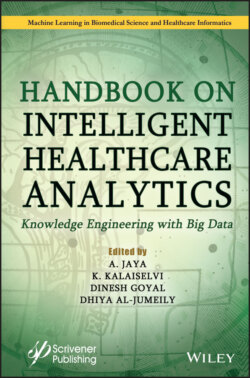Читать книгу Handbook on Intelligent Healthcare Analytics - Группа авторов - Страница 50
2.3 Proposed System
ОглавлениеThe proposed system deals with the improved IBHMF that was interconnected with probability of continuous data for classification in sequence. In IBHMF model, the weather forecasting features are in sequence, which gets frequent updates such that hidden nodes or states can monitor the variations. To identify the hidden node, there is inference included for decoding the features using the Viterbi techniques [4, 9]. Also, the transition matrix along with probability distribution is gathered from the likelihood formulation. Let us consider the features from the weather forecasting dataset downloaded from Kaggle. The features are entity, node, year, total economic damage from natural disasters (US$), and number of reported natural disasters (reported disasters). All natural disasters. Entities are observing the matrix that can be trained based on forward-backward rules. Table 2.1 defines the entity of the weather forecasting dataset [9].
Table 2.1 Entities from weather forecasting dataset.
| Natural disasters | |
| Drought | |
| Earthquake | |
| Wildfire | |
| Volcanic activity | |
| Dry | |
| Landslide | |
| Flood | |
| Extreme weather | |
| Extreme temperature |
Daily weather can be defined, for instance, such that probability can be calculated {flood, landslide, volcanic activity} for processing the chain rule. These rules can find the instance according to Equation (2.1). The tokenized probability of each word that depends on the previous state is not updated with possibilities of visited information. To find the transition matrix and develop the graph above, illustrated states (three states) are considered between the probability rates in matrix format. Such a way, i and j are rows and columns that can build the matrix between transition form. In frequent interval, the time duration is also updated to know the last visited state along with the i-th entry of the possible probability toward the vector form of k-terms. So, in terms of year and hidden state, the climate changes and causes also differ.
Weather changes as non-probabilistic distance variation and then likelihood also become a problem such that maximization for change of directions remains same. The next state can be predicted using Markov chain model from the sequence of random generation of updates. Let us consider the state variables as state, followed with variables
Using the state estimation from Kaggle dataset data has been fed as an input layer; later, the hidden layer along with the weight (W) and bias (b) are initiated to classify the preprocessed data to predict the climatic change. The outputs expected from the reliable entity from a dataset such as extreme weather, dry, drought, and temperature change can be categorized using the value that creates the DAG form, which can avoid statelessness in nature. This model from the proposed work uses this stateless approach where the updates can memorize the information as analyzed from the buffer for unique classification on time series.
Weather forecasts always modify the day-wise improvement and random changes; Markov chain rule gives the priority to improve the challenge. Figure 2.2 shows the estimation of two different objects that are allowed from unique classes from the multilevel approach. The transition matrix from the level of updates can be prioritized, which can indicate the entity model id. The set of variables that are numeric and the updates that are based on the year-wise–dependent variable shows the economic difference. When the length and hidden states always vary based on the categories, the probability distribution are formulated. Later, covariation needs to be observed for probability distribution and rows are taken for x, y matrix, which are necessary to calculate the transition element wise. Rows and columns from the GPS are stochastic matrices, which are identified for performance as scalar value. Maximum likelihood has been generated to find the requirement of forecasting directions.
Figure 2.2 Proposed system for predicting disaster using improved Bayesian hidden Markov frameworks (IBHMF).
